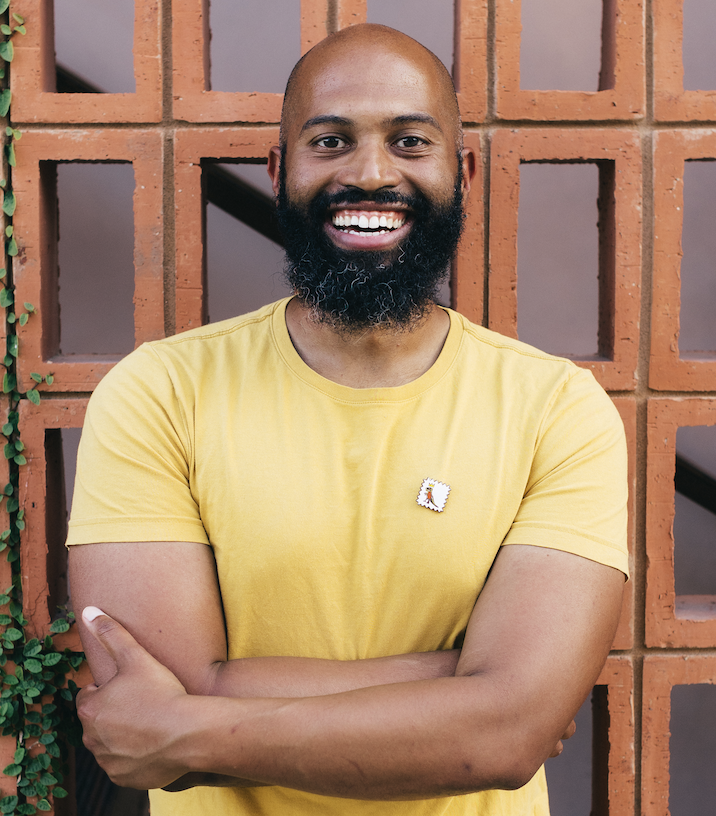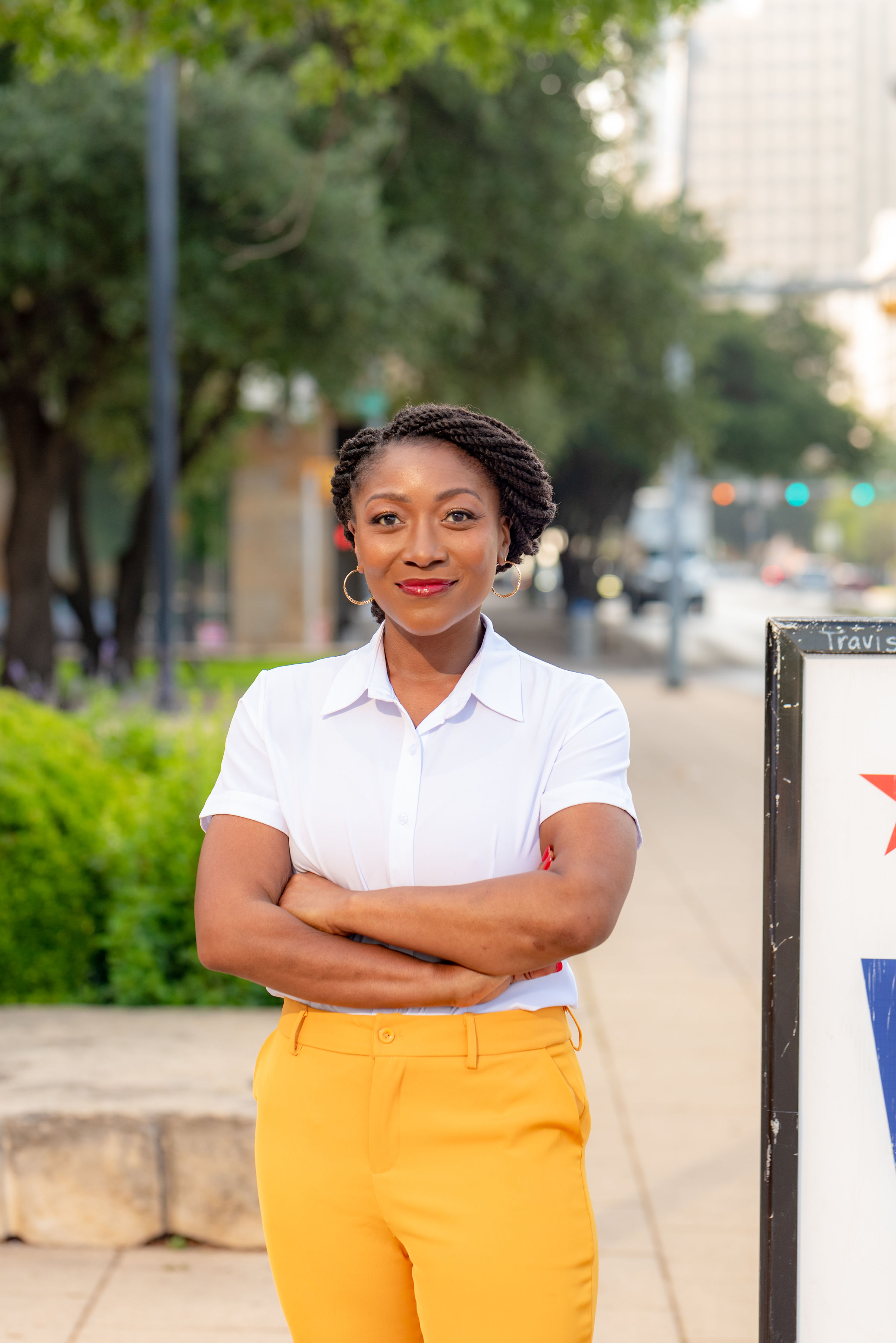Incumbent Council Member Natasha Harper-Madison has held the District 1 seat since 2019 and is facing off against challengers Misael D. Ramos, Clinton Rarey and Melonie House-Dixon.
The four candidates have raised nearly $158,500 combined, led by Harper-Madison's $144,700 in fundraising this year. She reported having just under $62,000 of that total remaining as of late September, while her three competitors reported having between $526 and $8,867 on hand as of last month.
Learn more about the candidates ahead of the Nov. 8 election. Early voting will run Oct. 24-Nov. 4, and more information about voting in the election can be found through the Travis County clerk's office.
*Indicates incumbent

Misael D. Ramos
Experience:
Blackland Community Development Corp. president developing affordable housing; worked with city officials to help create programs and advocate for antidisplacement initiatives; acted as a neighborhood association vice president working to preserve the East Austin community; manager of a team at an organization committed to helping people get jobs; 15-year Austinite with heavy involvement in community advocacy for nine years
Occupation:
Indeed business analyst manager, Blackland Community Development Corp. president
Candidate Website:
https://misaelramos.com/
Contact Information:
512-827-7287
How would you work to tackle the issue of housing affordability for both renters and homeowners in the city?
Development can be responsibly managed and encourage the kinds of built communities that consider affordability. This requires a change in the transparency of processes and incentives for responsible development (like waivers for building affordable units or preserving historic buildings). Looking at development policies more carefully is also an opportunity to involve existing communities—many of the best solutions for affordability issues for both renters and homeowners come from the community level.
How safe do you believe Austin is today? Do you think any funding, staffing or operational changes are needed in the city's public safety departments?
Austin is as safe as it is connected. The highest measures of safety are trust and stability in communities. Displacement causes safety issues for all and can be avoided with policies that address inequities and irresponsible development at the root of displacement. A safe Austin looks like a city that can trust its public servants and has specialized roles for crisis needs.
How do you believe city resources should be used to address homelessness? What do you see as the most effective policy options to get people services and housing?
I believe prevention and rehabilitation is a best use of resources. Mental health services in this city are spread thin, and with more funding going to punitive measures we risk making the problem worse. More funds could be allocated to preventative, wraparound services, units for housing and universal income guarantees.
What aspects of the city's land development code, if any, would you propose to review? How do you believe council should handle Austin's ongoing growth and its existing neighborhoods, from individual zoning cases to broader policy updates?
I've been working directly with the land code through my involvement with preservation and Blackland Land Trust. It is time for a bringing the code up to date with the reality of development in Austin. One change I foresee is revising permiting procedures to incentivize truly affordable housing and offsetting development fees for programs that will ensure affordability is real and accessible to those who need it most.
Austin has weathered several disasters in recent years. How would you rate the city's response to such incidents, and what changes, if any, would you propose for civic emergency management operations?
With a growing population and escalating climate change threats, the city faces a serious challenge. "Crisis Hubs" are a proposed city solution, which I support—as long as community needs remain at the forefront and response is timely. We must work together to remain prepared. Where infrastructure failed us in the past, community stepped in.

Clinton Rarey
Experience:
Military; government; small-business owner
Occupation:
Self-employed (solar/roofing)
Candidate Website:
https://www.clintonrarey.com/
Contact Information:
512-436-3573
How would you work to tackle the issue of housing affordability for both renters and homeowners in the city?
I would reduce the fees we charge to build by more than 50%. There is no excuse why Austin is the second most expensive city to build in behind Liberty Hill that has a population of 5,000. This would allow smaller mom-and-pop developers to compete in the housing market. Driving down costs and putting more houses/units on the market. Next I would expedite the permitting process to automatically approve a permit after it reaches 30 days. Lastly, I would require all department service employees to be in the office five days a week versus the three they currently are required.
How safe do you believe Austin is today? Do you think any funding, staffing or operational changes are needed in the city’s public safety departments?
Austin is not safe. The murder rate has doubled under "Re-imagine Policing;" our current leaders are separated from reality. Even their utopian goal of Vision Zero has made our roads more dangerous. Traffic fatalities have gone up since Vision Zero was initiated as has murder with Reimagine Policing. It's going to take proper staffing levels and a district attorney who will actually prosecute criminals instead of releasing them back onto the street to committee murder. 46% of all the solved murders in 2021 were violent repeat offenders Jose Garza put back on the street that went on to kill someone 6-9 months after being released.
How do you believe city resources should be used to address homelessness? What do you see as the most effective policy options to get people services and housing?
The city should not be wasting money on hotels or permanent housing. It is not the city's responsibility to create housing. The city is supposed to provide resources for people to become self-sufficient. We should be focusing on creating a large temporary shelter to immediately get everyone off the street/woods. Once we have everyone in a temporary shelter we can figure out who is chronically homeless and if they qualify to live at the Community First Village. Figure out who needs mental health services and substance abuse services to reach recovery hiring social workers, doctors, nurses, psychologists to treat those individuals. Lastly connecting people who need job training with the free vocational training we have here in Austin or job placement. We will never end homelessness in Austin, but we can bring it to a point where only less than 100 people are facing homelessness at any given point that can be managed by our permanent shelter.
What aspects of the city’s land development code, if any, would you propose to review? How do you believe council should handle Austin’s ongoing growth and its existing neighborhoods, from individual zoning cases to broader policy updates?
I believe the city land development code should be reviewed to create a more equitable access to multifamily units for those considered low income or poverty level that has easy access to public transportation or close to the transit corridor. When it comes to individual zoning cases I fall to the local community and whether they are for or against it which is their right to petition zoning changes. I will stand with what that neighborhood or community wants. I will never vote against their wants or needs.
Austin has weathered several disasters in recent years. How would you rate the city's response to such incidents, and what changes, if any, would you propose for civic emergency management operations?
The city should have action plans for any possible disaster and train first responders either annually or biannually on these potential disasters. Currently, the city has an F rating in my book.

Melonie House-Dixon
The questionnaire was not returned by the deadline.

Natasha Harper-Madison*
Experience:
City Council representative for District 1, city of Austin; business owner/self employed, East Austin Advocates; small-business owner/self employed, Take5ToVote; small-business owner/self employed, The Floral Engagement; small-business owner/self employed, EcoChic Floral; small-business owner/self employed, Harper-Campbell Domestic Do It All
Occupation:
Austin City Council Representative for District 1
Candidate Website:
https://www.natashaforaustin.com/
Contact Information:
512-200-3703
How would you work to tackle the issue of housing affordability for both renters and homeowners in the city?
The only effective solution to our affordable housing crisis is to significantly increase our housing supply. We need housing, housing and more housing. We must work together to remove unnecessary impediments to growth and eliminate unnecessary roadblocks to development. We can increase our housing supply partly by streamlining our building permitting processes and making sensible changes to our obsolete Land Development Code. Our Land Development Code, as it stands today, is rooted in exclusionary policies that prevent growth at the rate that is needed to keep up with demand. To have a sustainable housing supply that serves the needs of our residents now and into the future, we must equitably increase the supply of both market-rate and affordable housing options and center this dense new growth along transit corridors and close to public transportation. For too long the city has held a car-oriented mindset, and, as a result, we have lost out on optimizing livable space. When we increase our housing supply in an equitable and transit-oriented fashion, we will lower transportation costs, increase the city’s return on its public transportation infrastructures and reduce our carbon emissions. Equitable and transit-oriented development is right for the people, right for the city and right for the environment.
How safe do you believe Austin is today? Do you think any funding, staffing or operational changes are needed in the city’s public safety departments?
Austin is a safe city relative to other large metropolitan areas, but I know that we can do better from a public safety perspective. Responsible police officers are vital and serve an extremely important role in providing a safe community for all of our families to live in. Policing is a tough job, and we ask too much of our police officers these days. In addition to enforcing our laws, we expect them to fulfill the roles of social workers, conflict negotiators and medical responders. Before we move forward with our policing strategy, we must take a hard look at our current approach to public safety, and discuss and debate in an open and democratic forum the systemic and cultural changes that are needed. Everything from onboarding and training processes for new cadets to handling of complaints and citizen oversight needs to be re-examined. We must transition away from the current warrior mindset and encourage a more guardian mindset. Officers should be better trained in de-escalation techniques, and we should have a diverse police force that reflects the diversity of the community they are sworn to protect.
How do you believe city resources should be used to address homelessness? What do you see as the most effective policy options to get people services and housing?
We must work harder to address the root causes that lead to homelessness. Criminalizing vulnerable and marginalized members of our community does not fix the problem. Increasing access to affordable mental health care resources and substance abuse recovery programs is essential, but not every homeless person is mentally ill or a drug addict. Many unhoused people and families have just had a run of unfortunate luck and need a little bit of stability and help getting back on their feet. We must identify and recognize the variety of different circumstances that lead to homelessness. Only then we can begin to effectively address them. We must provide our unhoused with a safe and stable environment and do so in a manner that will help them to eventually get into homes and live independently again. Unfortunately this is not an uncommon issue. Many other cities around our nation are facing similar issues. But a common theme we have seen is that it is only in helping the unhoused address the issues that led to their homelessness—not in turning to punitive action—that we can find a solution that truly gets people off the street and sustainably into homes.
What aspects of the city’s land development code, if any, would you propose to review? How do you believe council should handle Austin’s ongoing growth and its existing neighborhoods, from individual zoning cases to broader policy updates?
Parking minimums and compatibility standards both need to be explored and reimagined. Parking minimums place a significant cost on new developments and are oftentimes unnecessarily high. Again, the focus is too heavily reliant on a car-oriented development mindset. In addition to the purchase itself, research shows that the average annual cost to operate a vehicle is $10,000 a year. In a city where rents and housing costs have skyrocketed, it is no longer reasonable nor pragmatic to continue developing with this type of car-oriented mindset. We need to revamp the code and allow builders to build more vertically and along dense transit corridors that make mobility easier for all Austinites. We should grow the city with a purpose of making it cheaper and easier for people to move around the city.
Austin has weathered several disasters in recent years. How would you rate the city’s response to such incidents, and what changes, if any, would you propose for civic emergency management operations?
We have faced some serious challenges these past several years. Winter Storm Uri really tested the limits of our community, and while we were able to ultimately get our water and energy up and running again, it took too long and shined some light on areas of our emergency management preparations that could use some help. I think the city did all that it could from a reactionary stance, but we should have done more from a preventative stance. Just three months ago, during a day of 103-degree heat, my office received a call from a pair of elderly constituents that had lost power. One of these was a cancer patient, and I am proud of the hard work my staff did to quickly find resources and a hotel room for these people, but not before the power had come back on. Moving forward, it became apparent that we need a comprehensive, easy-to-follow and widely disseminated plan just for heat-related emergencies. I look forward to working on this more in my second term.





